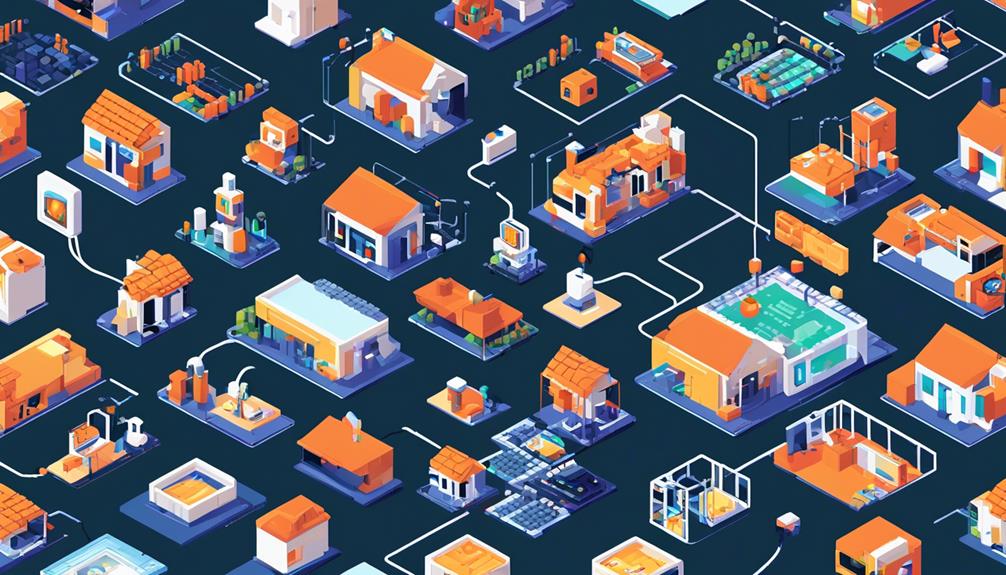In today's digital landscape, businesses are increasingly leveraging IoT infrastructure to optimize their operations, improve efficiency, and enhance customer experiences. IoT infrastructure serves as the backbone for connecting devices, sensors, and software, enabling seamless communication, real-time data collection, and analysis.
However, understanding the intricacies of IoT infrastructure can be a complex endeavor. From essential hardware components and scalability considerations to the key role of data management and the importance of IoT security, there are various aspects to explore and comprehend.
In this discussion, we will delve into the technical aspects of IoT infrastructure, providing a detailed understanding of its hardware, software, and security components, and why it is crucial for businesses to grasp these concepts to stay competitive and thrive in the digital age.
Key Takeaways
- IoT infrastructure hardware includes physical devices, controllers, sensors, actuators, and network components.
- Sensors collect data from the environment, while actuators perform physical actions based on that data.
- Gateways and routers facilitate communication between IoT devices and networks.
- Cloud computing integration is essential for storing, processing, and analyzing large volumes of IoT data.
IoT Infrastructure Hardware
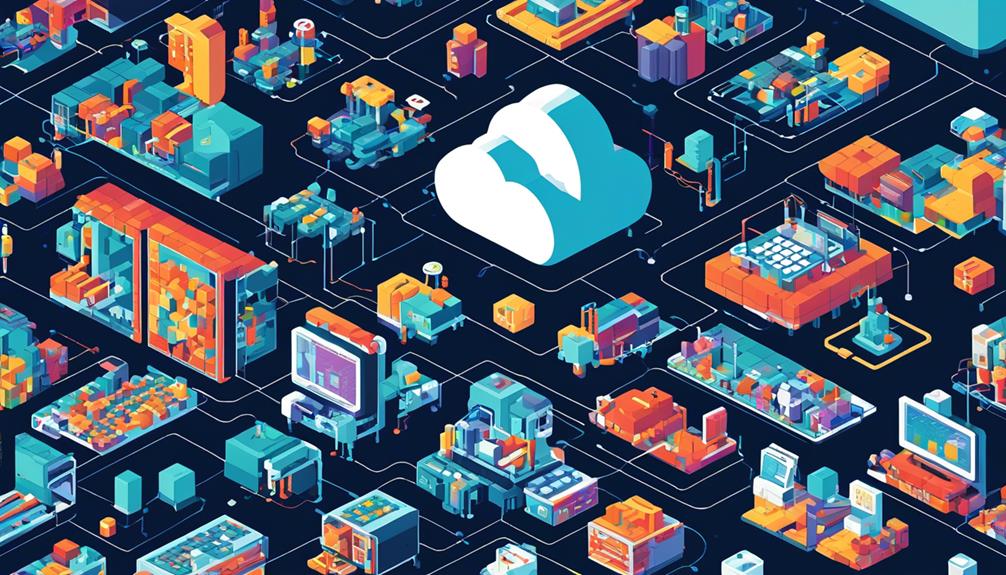
IoT infrastructure hardware consists of physical devices and controllers that adhere to IoT standards, ensuring seamless communication within the IoT ecosystem. These hardware components are responsible for connecting IoT devices and sensors to the network, enabling the collection and transmission of data.
IoT infrastructure hardware includes a wide range of devices such as sensors, actuators, gateways, and edge devices. Sensors are an essential part of IoT hardware as they gather information from the environment and convert it into digital data. Actuators, on the other hand, receive instructions from the network and perform physical actions based on the received data.
To establish connectivity, IoT hardware relies on various network components such as routers, switches, and gateways. These components enable the transfer of data between devices and ensure efficient communication within the IoT network.
Data storage is another critical aspect of IoT infrastructure hardware. Large volumes of data collected from IoT devices need to be stored securely and efficiently. Fast and scalable storage technologies, such as cloud storage, are commonly used to handle this immense data.
Security is a paramount concern when it comes to IoT infrastructure hardware. As the number of connected devices continues to grow, ensuring the security of these devices and the data they generate becomes increasingly challenging. Hardware components need to incorporate robust security measures, including encryption, authentication, and access control, to protect against potential threats and unauthorized access.
Essential Hardware Components
To understand the essential hardware components of IoT infrastructure, we must first consider sensors and actuators. Sensors gather data from the physical environment, while actuators enable physical actions based on that data.
Another crucial component is gateways and routers, which facilitate communication between devices within the IoT network and prepare data for transfer to the cloud.
Lastly, cloud computing integration is vital for storing, managing, and processing the massive volumes of data collected from IoT devices.
Sensors and Actuators
Sensors and actuators are pivotal components of IoT infrastructure, playing a fundamental role in collecting data from the environment and executing actions based on that input. These essential hardware components enable the acquisition of data in the industrial IoT, healthcare, manufacturing, and smart home sectors. Here are three key points to consider:
- Data Acquisition: Sensors act as the eyes and ears of IoT devices, collecting information such as temperature, humidity, motion, and more. This data is crucial for monitoring and decision-making processes.
- Automation and Control: Actuators, on the other hand, perform actions based on the input received from sensors. They enable the automation and control of devices, allowing for remote operation and optimization of processes.
- Integration and Communication: Sensors and actuators work in conjunction with IoT protocols, edge computing, IoT platforms, and the IoT network to ensure seamless integration and communication within the IoT ecosystem.
Gateways and Routers
Gateways and routers are crucial components of IoT infrastructure, serving as essential hardware for facilitating seamless communication between devices.
IoT gateways act as intermediaries between different communication protocols, allowing devices to connect to the internet without intermediaries. They ensure that sensor data is efficiently prepared, transmitted, and managed within the IoT ecosystem.
On the other hand, routers play a crucial role in directing data traffic within an IoT network, managing data transmission between different networks.
Together, these components make up the robust IoT architecture required for an effective network of devices. Gateways and routers enable the smooth flow of data and communication between IoT devices and the cloud, ensuring efficient data management throughout the network.
Their integration with hardware and software is essential for building a reliable and secure IoT infrastructure.
Cloud Computing Integration
Cloud computing integration in IoT requires the incorporation of essential hardware components such as physical devices, controllers, networks, data storage, cloud computing, and edge computing. These components play a crucial role in connecting and processing data from IoT devices.
Here are three key points to consider:
- Scalability and Flexibility: Cloud computing provides resources on-demand, allowing IoT systems to easily scale up or down based on the needs of the application. It offers the flexibility to adapt to changing requirements and seamlessly integrate with IoT platforms.
- Big Data Analytics: With the billions of devices connected to the internet, IoT generates a large volume of data. Cloud computing enables the handling and analysis of this data, providing valuable insights through advanced analytics and machine learning algorithms.
- Supporting Infrastructure: Cloud computing provides the necessary infrastructure to support IoT and Big Data applications. It allows for real-time analysis and decision-making, making it an essential component for industry leaders in IoT.
Building IoT Infrastructure
When building IoT infrastructure, it is crucial to consider the key components and connectivity options.
The key components include internet connectivity, network technologies like Wi-Fi, Bluetooth, fiber optic cables, and 5G, as well as specialized sensors and software.
The choice of connectivity options will depend on factors such as range, data transfer speed, and power efficiency, which need to be carefully evaluated to ensure optimal performance and scalability of the IoT infrastructure.
Key Components
To build a robust IoT infrastructure, it is crucial to understand and incorporate the key components that form the foundation of an effective IoT network. These components include:
- Physical Devices and Controllers: IoT networks consist of numerous smart devices and sensors that collect data and transfer it to the network for processing. Examples of IoT devices include wearables, industrial sensors, and smart home appliances.
- Network: A reliable and secure network is essential for connecting the large number of IoT devices. It enables the seamless transfer of data between devices and the central IoT infrastructure.
- Data Storage, Cloud Computing & Edge Computing, and Big Data Analytics: The volume of data collected from IoT devices is massive, and efficient storage and processing methods are required. Cloud computing and edge computing technologies are used to store and process this data, while big data analytics helps extract valuable insights from the vast amount of information.
Connectivity Options
In order to establish a robust and efficient IoT infrastructure, it is imperative to carefully consider the connectivity options available for building the network.
Connectivity options play a crucial role in ensuring seamless communication and data transfer between IoT devices, sensors, and the internet.
In consumer IoT, Wi-Fi is commonly used for local network connection, allowing devices to connect to the internet and exchange data. Bluetooth is also gaining popularity in consumer IoT for linking devices to mobile networks.
For industrial IoT, fiber optic cables provide unlimited bandwidth and high-speed data transfer, making them suitable for applications that require large amounts of data, such as in supply chain management. Additionally, 5G technology ensures low latency and connectivity for a large number of devices, making it ideal for industrial IoT applications that require real-time data processing.
Choosing the right connectivity option is essential for building a robust and efficient IoT infrastructure that can support the diverse needs of businesses and industries.
Scalability and IoT Systems
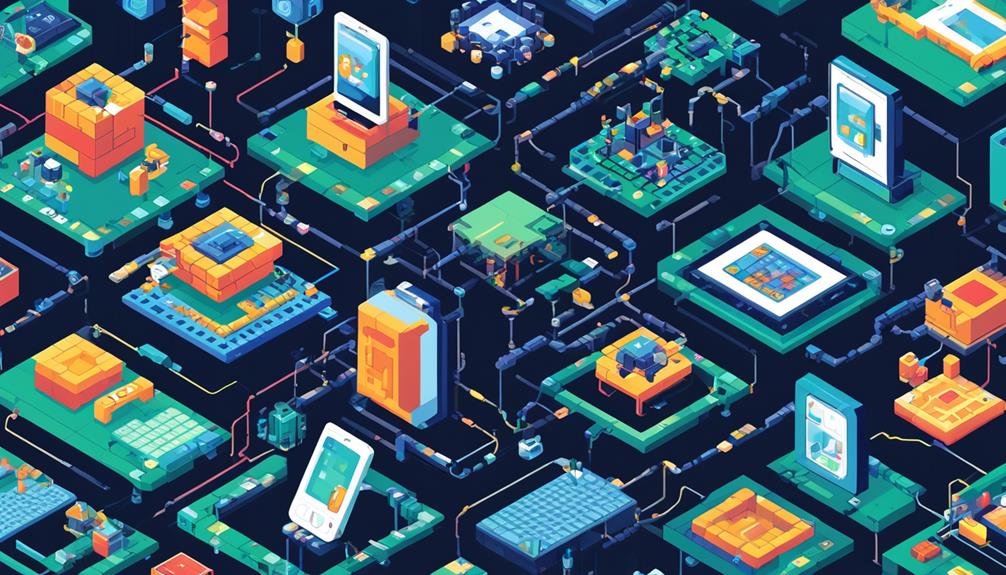
Scalability, a crucial aspect of IoT systems, pertains to their ability to efficiently handle the increasing influx of devices and data while maintaining optimal performance levels. As the number of connected devices and the volume of data they generate continue to grow, it is essential for IoT systems to be scalable.
Here are three key points to understand about scalability in IoT systems:
- Accommodating Increasing Numbers of Devices and Data: Scalability in IoT systems enables them to handle the growing number of connected devices seamlessly. This requires the ability to efficiently process and manage the increasing volume of data generated by these devices. Without scalability, IoT systems may struggle to handle the influx of devices and data, leading to performance issues and potential system failures.
- Robust Network Infrastructure: Scalability in IoT systems relies on a robust network infrastructure that can support the increasing demands of connected devices. This includes reliable communication protocols and a wireless network that can handle the growing data traffic. A well-designed network infrastructure ensures that the system can scale effectively without compromising performance or reliability.
- Flexible Architecture Design: An effectively scalable IoT system is built with a flexible architecture design. This allows for seamless integration of new devices and technologies as the network expands. A flexible architecture enables the system to adapt and accommodate future growth without the need for significant modifications or disruptions to the existing infrastructure.
Key Role of Data Management
With the increasing influx of devices and data in IoT systems, effective data management plays a pivotal role in ensuring the efficient collection, storage, and analysis of the vast amounts of data generated. Understanding the key role of data management in IoT infrastructure is crucial for organizations looking to harness the full potential of IoT-generated data.
In IoT environments, data management involves implementing strategies for data governance, data quality, data integration, and data lifecycle management. These strategies are essential for deriving meaningful insights from the massive volume of data generated by diverse IoT devices. To illustrate the importance of data management in IoT, consider the following table:
| Data Management Strategy | Description | Importance |
|---|---|---|
| Data Governance | Establishing policies and procedures for managing and protecting IoT data. | Ensures data security and compliance. |
| Data Quality | Ensuring the accuracy, completeness, and consistency of IoT-generated data. | Enables informed decision-making and reliable analysis. |
| Data Integration | Combining data from different IoT devices and sources to gain a holistic view. | Facilitates a comprehensive understanding of IoT systems. |
| Data Lifecycle Management | Managing the entire lifecycle of IoT data from collection to disposal. | Optimizes data storage, retrieval, and archiving processes. |
Implementing these data management strategies addresses challenges such as data silos, data interoperability, and data privacy in IoT environments. By taking care of these challenges, organizations can leverage IoT-generated data to improve operational efficiency, enable predictive maintenance, and facilitate real-time monitoring and control of IoT devices and systems.
In addition to these benefits, effective data management in IoT infrastructure also enables organizations to securely store and share data. This is particularly important in Consumer IoT scenarios where individuals use IoT devices to collect and exchange data for various purposes.
Software for Business Needs
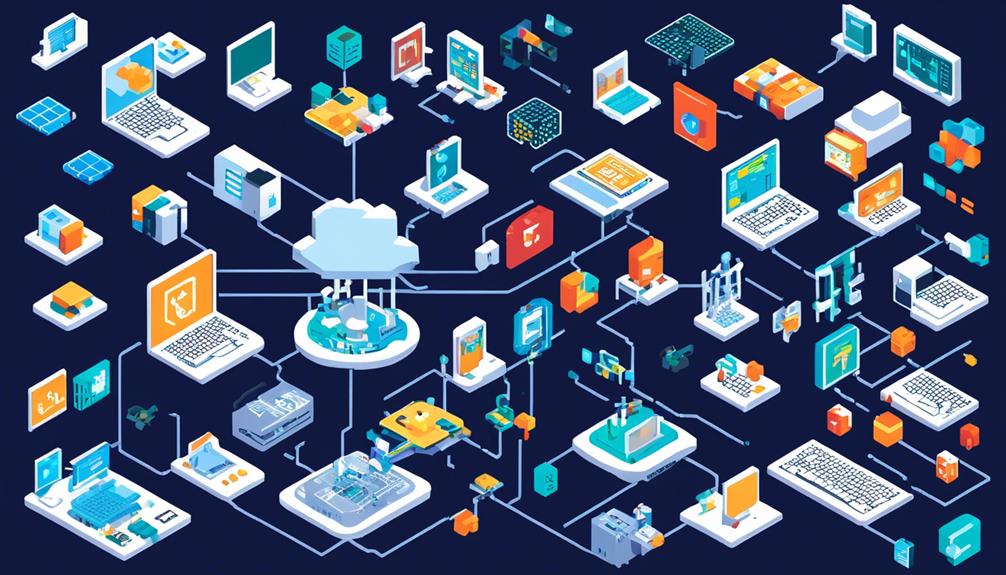
Effective software solutions tailored to meet the specific business needs of organizations operating in IoT environments play a pivotal role in enabling seamless data collection, analysis, and management. IoT software applications serve as the backbone of IoT infrastructure, facilitating the automation of various processes without human intervention.
Here are three key points highlighting the importance of software for business needs in IoT:
- Real-time insights and data-driven decision-making: IoT software enables organizations to collect and analyze data from connected devices, providing real-time insights into their operations. This data-driven approach allows businesses to make informed decisions and optimize their processes for improved operational efficiency.
- Specialized software for different industries: Each industry has its own unique challenges and requirements within IoT infrastructure. Therefore, specialized software solutions are necessary to address these specific needs. For example, in smart cities, IoT software can be used to manage traffic flow, monitor air quality, and optimize energy consumption.
- Security and privacy considerations: With the increasing number of connected devices transmitting data to the cloud, security and privacy become paramount concerns. IoT software for business needs must incorporate robust security measures to protect sensitive data and ensure secure communication between devices and systems.
User-Friendly IoT Apps
In the context of IoT infrastructure, the development of user-friendly IoT apps is essential to ensure seamless interaction with IoT devices and efficient access to data. These apps play a crucial role in bridging the gap between users and the vast ecosystem of IoT devices, sensors, and software that make up the IoT framework.
User-friendly IoT apps should provide a simple and intuitive user interface, allowing individuals to easily manage and control their IoT devices. They should offer features such as device management, allowing users to add, remove, and configure their devices with ease. Additionally, these apps should provide personalized customization options, enabling users to tailor settings and preferences to their specific needs.
Data visualization and reporting are key components of user-friendly IoT apps. Clear and concise presentation of data collected by IoT devices helps users understand and interpret the information effectively. By providing visual representations and reports, these apps enable users to gain valuable insights and make informed decisions based on the data collected.
Security and privacy are paramount in user-friendly IoT apps. Users should have full control over their data and the ability to manage access permissions. Robust security measures should be implemented to protect IoT devices and networks from potential threats.
User-friendly IoT apps have a wide range of applications, from managing smart thermostats and lighting systems in residential settings to monitoring and controlling complex industrial operations. By offering a user-friendly experience, these apps empower individuals and businesses to capitalize on the benefits of IoT technology while minimizing complexity and maximizing efficiency.
Importance of IoT Security
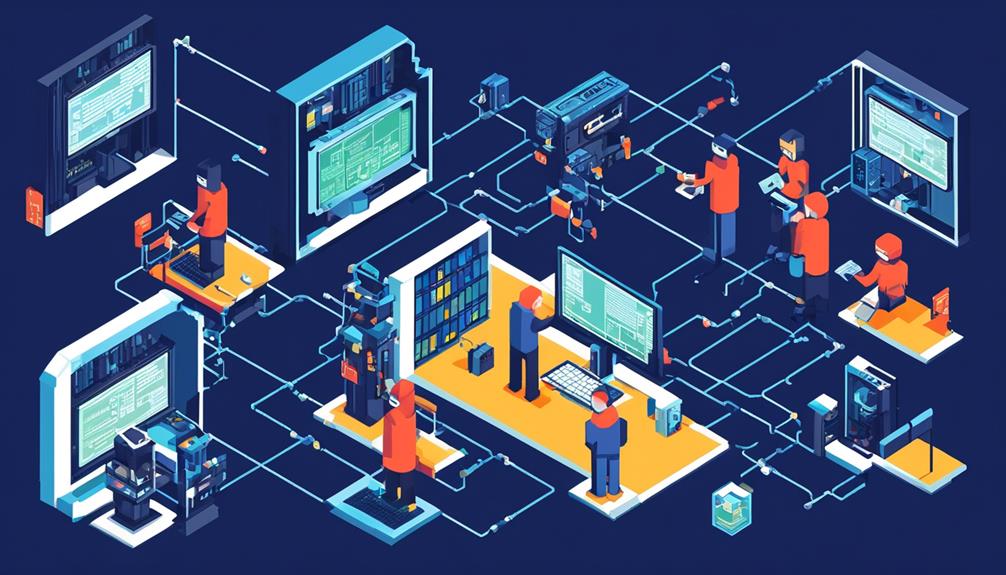
IoT security is an indispensable aspect of ensuring the protection and integrity of IoT devices and data in the face of potential cyber threats and unauthorized access. With the increasing adoption of IoT devices and the interconnectedness of various systems, it has become crucial to prioritize security measures to safeguard against potential risks and vulnerabilities.
Here are three key reasons why IoT security is of utmost importance:
- Protection against cyber threats: As IoT devices become more prevalent in our daily lives, they also become attractive targets for hackers. Without proper security measures, these devices can be vulnerable to hacking, data breaches, and privacy violations. Implementing strong security protocols and encryption techniques is vital to safeguard IoT ecosystems from potential cyber attacks. This not only protects the data being transmitted but also ensures the reliability and availability of the IoT infrastructure.
- Preservation of data integrity: IoT devices collect and transmit vast amounts of data, making data integrity a critical concern. Any unauthorized access or tampering with this data can lead to severe consequences, especially in industries that rely on IoT for critical operations, such as healthcare or industrial equipment. Ensuring IoT security helps maintain the integrity and reliability of this data, allowing businesses to make informed decisions based on accurate and trustworthy information.
- Building trust and confidence: IoT security is essential for building trust and confidence among users and businesses using IoT technology. By addressing privacy issues and protecting sensitive data, organizations can establish credibility and reassure users that their information is safe. This is particularly important in sectors where privacy and data protection are paramount, such as healthcare and finance.
Frequently Asked Questions
What Is the Infrastructure of Iot?
The infrastructure of IoT encompasses various components and technologies that enable its functionality.
IoT architecture involves the design and arrangement of interconnected devices, sensor networks, and communication protocols.
Network connectivity ensures seamless data transfer between devices and systems.
Data processing, both at the edge and in the cloud, enables real-time analytics and insights.
Security and privacy measures protect sensitive information.
Scalability and flexibility allow for the expansion and integration of new devices.
Device management ensures efficient operation and maintenance of IoT systems.
What Are the 4 Main Components of Iot System?
The four main components of an IoT system are:
- Sensor technology: This component involves collecting data from the environment. Sensors are used to detect and measure various parameters such as temperature, humidity, light, and motion. They play a crucial role in gathering the necessary data for the IoT system to function.
- Wireless connectivity: This component enables the transfer of data between devices. It allows the sensors to send the collected data to the central system for processing and analysis. Wireless connectivity options include Wi-Fi, Bluetooth, cellular networks, and satellite communication.
- Data analytics: Once the data is collected, it needs to be analyzed and interpreted to extract meaningful insights. Data analytics involves using algorithms and techniques to process and make sense of the collected data. This component helps in identifying patterns, trends, and anomalies, which can be used for decision-making and optimization.
- User interface: The user interface component allows users to interact with the IoT system and access the processed data. It includes interfaces such as mobile apps, web portals, and dashboards. Users can monitor and control different aspects of the system through the user interface, making it an essential component for user experience.
These components are crucial for real-time monitoring, energy efficiency, and scalability of IoT systems. They enable the seamless collection, analysis, and presentation of data, making IoT systems effective and efficient. Additionally, security protocols and device management play a vital role in ensuring the integrity and reliability of the infrastructure.
What Are the 5 C's of Iot?
The 5 C's of IoT are:
Connectivity:
- Refers to the ability of IoT devices to connect and communicate with each other and other systems.
Cloud:
- Represents the use of cloud computing resources to store and process the data generated by IoT devices.
Cybersecurity:
- Encompasses the measures taken to protect IoT devices and data from unauthorized access and breaches.
Cognition:
- Involves the use of artificial intelligence and machine learning to derive insights and make decisions based on the data collected by IoT devices.
Compliance:
- Refers to adhering to regulations and standards related to data privacy, security, and industry-specific requirements in the context of IoT.
What Are the 4 Types of Iot?
The four types of IoT can be categorized as Consumer IoT (CIoT) and Industrial IoT (IIoT).
CIoT encompasses IoT applications and devices that enhance convenience and quality-of-life for individual users, including smart refrigerators, lighting systems, and wearable technology.
IIoT, on the other hand, focuses on improving business operations with applications such as facilities management, asset monitoring, and supply chain management.
Both types of IoT require robust security measures, efficient communication protocols, advanced data analytics, seamless connectivity, and integration with IoT platforms to keep up with the evolving trends in the industry.
